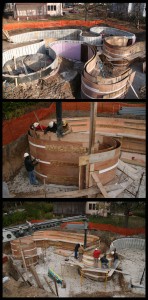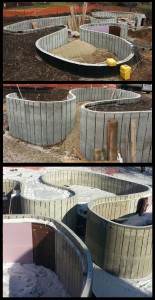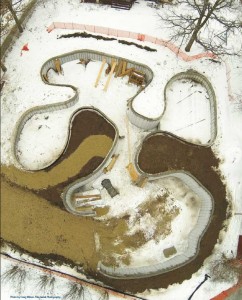The 2014 CFA Grand Project of the Year: A Madison Gardenesque
Another great year of project submittals demonstrating some of the most incredible construction feats is in the books.
A record number of votes recorded on the show floor at the World of Concrete in Las Vegas this past January and a strong online voting contingent evaluated the seven projects vying to be named a CFA Project of the Year.
This program continues to gain momentum throughout the industry, as companies look more and more to identify their strengths and talents to their market. At the same time, many companies want an opportunity to share lessons learned and have begun to identify with the advantage this program provides to do just that.
In this issue of Concrete Facts we have the privilege of introducing you to this year’s overall grand winner. This project received the highest rating across the board for all projects submitted and achieved a near perfect rating across all ballots cast.
What do you see when you look at this project? From World of Concrete, the overwhelming number of guesses was “one crazy looking swimming pool, right?” While this certainly would have been one crazy swimming pool…in Madison, Wisconsin, it is an even more amazing foundation wall for a new private residence.
CFA member and the contractor responsible for this quality foundation was Hottmann Construction Co., Inc. of Dane, Wisconsin. Ed Sauter, Executive Director for the CFA took some time to speak with Mike Thole, project manager for Hottmann, during the busy week at World of Concrete to better understand this amazing project.
Ed: Mike, thanks for taking some time to speak with me on this project. We’ve had hundreds of people through this booth this week that just can’t believe what you have accomplished. What can you tell us about this foundation?
Mike: The pictures of the curves in this house explain this better than any words. The longest “straight” wall was 15-feet, occurring at the garage doors. The foundation itself is somewhat modest in size compared to many of the projects seen in this competition at just under 3,000 square feet. Size didn’t really matter though as the real challenge for this project was the serpentine walls that we had to figure out how to form without the typical segmented approach using filler panels. That would never have worked in the first place as there wouldn’t have been enough fillers in our county to accomplish this feat.
Ed: The photos certainly do tell an unbelievable story here. The first question in everyone’s mind, after “what the…”, has to be wondering how you accomplished the forming for this wall. What can you tell us about it?
Mike: We stumbled across the Spider Tie company and accessed their expertise to design a forming system that could achieve the complexity of the irregular serpentine shape without risk of form pressure failure. They were extremely important to this project. The system allowed us to create even flowing curves in the foundation, as well as a plumb wall. We have done several curved wall projects in the past, but most of them had 15 to 20 feet of curved walls at the most.
Ed: So not only were you applying your construction experience to such an irregular form, you were also cutting your teeth on a new forming system. How did that work?
Mike: There was no precedence for this type of curved wall project in our company, so estimating was an educated guess with our management team. The major complexities were the shape, as well as a forming system that consisted of three (3) layers of 1/4” Luan plywood as the forms. We had to develop confidence that 3/4” total thickness of Luan plywood was going to withstand the pressures of the concrete being poured into the forms, and not blowout. As you can see, the scrutiny that we applied along with finally the faith that it would turn out resulted in a very high-quality product that both owner and architect were quite pleased with.
Ed: I’m sure there were some choice moments of reflection for the architect. How were you able to even begin to accomplish the task of translating this form to the site?
Mike: The shape was handled by transferring the plan into our Trimble LM-80 to lay the project out on the site. We had the luxury then of setting as many points as we thought was necessary to achieve the form. First with the footings and then with the walls, this gave us incredible accuracy and confidence in the preparation for the final product as well as our ability to maintain plumb walls. It is pretty safe to say that “squareness” wasn’t a real concern here.
Ed: We can see the adaptability of the forming system to the walls but what about the footings? How were you able to conform to shape and maintain the performance of the footing system?
Mike: One of the difficulties with the footings on this project was the Architect’s demand that the Form-A-Drain System was used to form the footings. We all know that this is a fairly rigid system, so creating curves like this required cutting the Form-A-Drain often and mitering the joints together to make these curves work. It was a very tedious process that perhaps entailed as much labor and time as any part.
Ed: What other complexities did the wall design provide for your team?
Mike: If the wall configurations were not crazy enough, the entire project also has brick ledge round it. The curves prevented the use of a traditional blocking system. Using the Spider Tie system, we were able to move the outside form six (6) inches inward and maintain its support to produce the brick ledge areas that ranged in height from 12 to 54 inches down from the top of wall.
 Ed: These are amazing images to view. Tell me about the location for this project. Many stopping by the booth this week expect this to be a lakehouse foundation once they are convinced it isn’t a swimming pool. Yet, it seems pretty clear this is more of an urban setting.
Ed: These are amazing images to view. Tell me about the location for this project. Many stopping by the booth this week expect this to be a lakehouse foundation once they are convinced it isn’t a swimming pool. Yet, it seems pretty clear this is more of an urban setting.
Mike: Yeah, the location was definitely another issue that we had to deal with in this project. The house is located in a well established, 100 year-old neighborhood in downtown Madison, WI. The lot size was so tight that it required us to complete the foundation in stages so the excavator could use dirt from digging the next section of house to backfill the area of the house that we had recently poured. This extended our time significantly and complicated supporting sections of the foundation early on, as well as then requiring construction joints throughout.
Ed: I also understand that your expertise, or rather the experience you gained through the two sets of layout continued to be beneficial for the project even after you were through with the concrete portion.
Mike: We developed a pretty good relationship with the general contractor and it was quickly apparent that a real hurdle would be encountered in trying to fabricate the sill plates. So, we took our Trimble LM-80, to the general contractor’s parking lot, laid the house out, and sprayed the layout with clear paint. This allowed the framing contractor to create jigs to follow the layout in the parking lot. He used these jigs, to create laminated sill plates, as well as laminated top and bottom plates for the framed walls above our concrete.
Ed: That is definitely amazing that your expertise extended through your scope of work and not only decreased their stress and increased their efficiency but perhaps even solved a seemingly unsolvable problem for them. This project is true concrete artistry at work.
Mike: Thanks very much. While no one can truly feel comfortable with how they come out on projects like this, we are very proud to have been selected as the foundation contractor and are pleased with the final product as well as the relationship building that was achieved through the effort. The project started out with two competing GC’s, both using us as the contractor of choice for the concrete package and in the end, the references they gave for us ensured that we would have a chance to set a new standard for our company and perhaps the industry.
This project is one of four projects winning coveted CFA Projects of the Year for 2014. Stay tuned in future issues of this magazine for some of the stories and photos from the other three projects, winning in the categories of Single-Family Residences under 2,000 sq.ft.; over 5,000 sq.ft. and Multi-Family/Commercial.
The full complement of this awards program can be viewed online at http://www.cfawalls.org/awards/project/index.html or by visiting the CFA’s website and selecting CFA Awards from the menu.
The CFA’s Projects of the Year is a free program open year-round to its members. To participate, a form is available for download at the address above, by emailing Jim Baty, Managing Director for the CFA, or by contacting CFA headquarters at 866-232-9255.
What the builder has to say:
Gary Feldt
Feldt Construction Co., Inc. 400 Venture Court, Suite 111 Verona, WisconsinThoughts from Gary: While we have constructed numerous houses with curved walls, they almost always have consistent and limited numbers of concentric radii. This home is obviously totally different with perhaps as many as fifty radii or more, a freeformed plan with very challenging dimensions and relationships. The success of this project was in large part due to Hottmann’s ability to shoot all of the stake points with their robotic layout equipment. Their company does virtually all of our work and we are very familiar with their staff and quality.
What the architect has to say:
Eric Richey
Thomas Phifer and Partners 180 Varick Street New York, New YorkThoughts from Eric: We are pleased with the way this project turning out. We were initially inspired by undulating masonry landscape walls that we observed in the US and Europe. These constructions were typically meant to separate properties but often incorporated a lyrical expression in their fabrication. Our initial visits to the site were during the summer months and the site was very lush, almost gardenesque and it was our intention to try and integrate or connect the program to this rich landscape. The program of a typical home can be organized as a series spaces. Our desire was to extract the sequential experience of these spaces and ground these spaces independently to the landscape. A byproduct of this decision making maximized the amount of natural daylight and views into each space of the house.
The shape is expressed by the foundation images and defined the spaces much like organic garden walls. Our desire to connect the house to nature and maintain the garden-like quality of the site was well received by the surrounding community. The contractor team of Feldt Construction Company and Hottmann Construction made this happen.
We anticipated communication challenges and extra work to translate the design to the built reality. Their experience, however, took our final concept and applied it through layout technology to an actual plan that really was pretty close to our expectations. The ability to then repeat this process from the foundation through the vertical walls, sill plates and top plates to the roof condition has been instrumental in the completion of this concept. Craftsmanship is timeless.
What the owner has to say:
The owner, John, was asked for a reflection on the structure:
For more than a century, the garden of two residences. The architecture is intended to represent this legacy simply and humbly. The house in essence is a garden wall.
One hundred years ago, when University Heights was a “streetcar” suburb of Madison, a garden wall could have sat here.
As the neighborhood grew and filled in, we wanted to reimagine how part of its face could be transformed into a home grounded in neighborhood history, aspiring to the best, progressive architecture of today, and faithful to the eternal spirit of the site itself.








